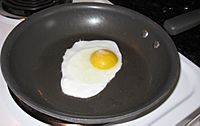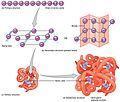Protein facts for kids

Proteins are super important molecules found in all living things. Think of them as tiny building blocks for your body! They are made from smaller units called amino acids. These amino acids link together like beads on a necklace, forming long chains. These chains then fold up into unique 3D shapes.
Proteins are involved in almost every job inside your cells. For example, many proteins are enzymes. Enzymes are special helpers that speed up chemical reactions in your body. Other proteins help build and support your body, like the ones in your muscles. They also help your cells talk to each other and fight off sickness.
Contents
Proteins: What They Do for You
Proteins have many different jobs. Their job depends on their unique shape. They are found in many foods you eat, like meat, eggs, milk, fish, beans, and nuts.
In your body, proteins are vital for growth and repair. They help build strong bones, muscles, and other body parts. When you eat protein, your body breaks it down into individual amino acids. These amino acids are then used to build new proteins that your body needs.
The way a protein works depends on a few things:
- The exact order of the amino acids in its chain. There are 20 different types of amino acids.
- How the chain twists and turns.
- How the entire structure folds up into its final shape.
- Sometimes, proteins are made of several smaller parts, called sub-units, working together. For example, haemoglobin (the protein in your blood that carries oxygen) is made of four sub-units.
Essential Amino Acids: Why Food Matters
Your body can make most of the amino acids it needs. However, there are some amino acids that your body cannot make. You must get these special amino acids from the food you eat. These are called essential amino acids.
There are nine essential amino acids for humans: histidine, isoleucine, leucine, lysine, methionine, phenylalanine, threonine, tryptophan, and valine.
Many animal products, like meat, contain all the essential amino acids you need. Most plants do not have all nine essential amino acids on their own. But don't worry if you eat mostly plants! You can get all the essential amino acids by eating a mix of different plant foods. For example, eating wheat with peanut butter, or rice with beans, gives you all the necessary amino acids. Foods like soy products (like tofu) and quinoa are also great sources of all essential amino acids.
The name "protein" was given by a scientist named Jöns Jacob Berzelius. Many other scientists have studied these amazing molecules since then.
Related pages
Images for kids
-
John Kendrew with model of myoglobin in progress
-
Chemical structure of the peptide bond (bottom) and the three-dimensional structure of a peptide bond between an alanine and an adjacent amino acid (top/inset). The bond itself is made of the CHON elements.
-
Resonance structures of the peptide bond that links individual amino acids to form a protein polymer
-
The crystal structure of the chaperonin, a huge protein complex. A single protein subunit is highlighted. Chaperonins assist protein folding.
-
Three possible representations of the three-dimensional structure of the protein triose phosphate isomerase. Left: All-atom representation colored by atom type. Middle: Simplified representation illustrating the backbone conformation, colored by secondary structure. Right: Solvent-accessible surface representation colored by residue type (acidic residues red, basic residues blue, polar residues green, nonpolar residues white).
-
Molecular surface of several proteins showing their comparative sizes. From left to right are: immunoglobulin G (IgG, an antibody), hemoglobin, insulin (a hormone), adenylate kinase (an enzyme), and glutamine synthetase (an enzyme).
-
The enzyme hexokinase is shown as a conventional ball-and-stick molecular model. To scale in the top right-hand corner are two of its substrates, ATP and glucose.
-
Ribbon diagram of a mouse antibody against cholera that binds a carbohydrate antigen
-
Proteins in different cellular compartments and structures tagged with green fluorescent protein (here, white)
-
Constituent amino-acids can be analyzed to predict secondary, tertiary and quaternary protein structure, in this case hemoglobin containing heme units
See also
 In Spanish: Proteína para niños
In Spanish: Proteína para niños









